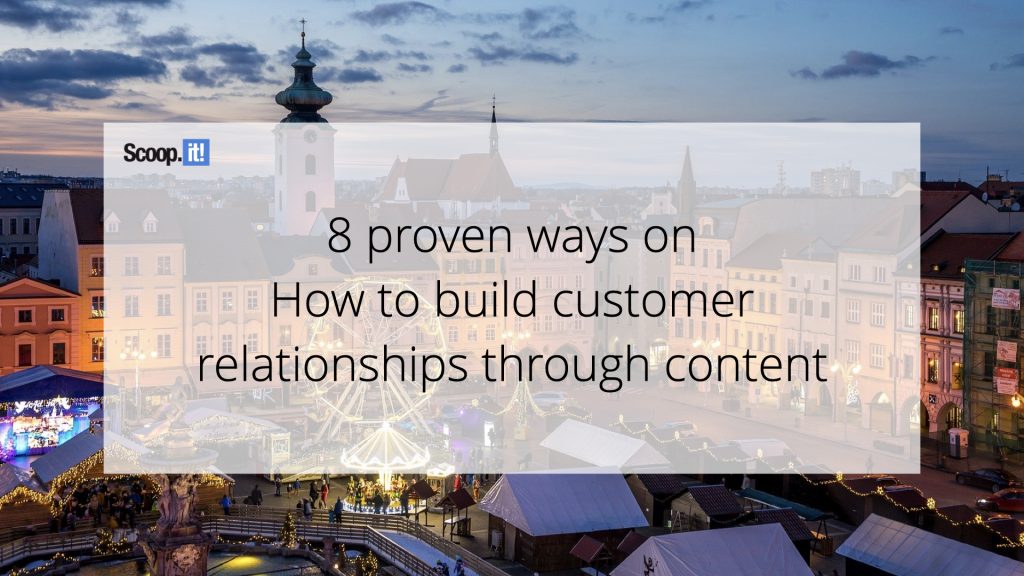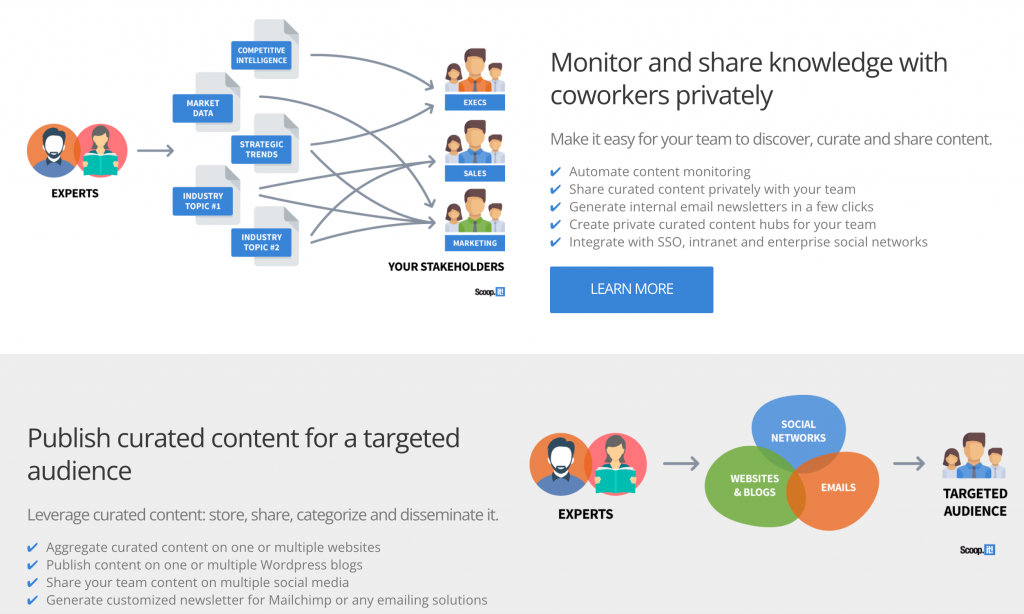
While the phases of a marketing tunnel differ for each business, the main goals are the same: to engage with them at every opportunity, convert them into customers – and keep them coming back for more. In order to do this, you need to know how to build customer relationships that last.
To achieve this goal, there’s one approach you cannot do without: an effective content marketing strategy.
Creating and sharing high-quality organic content in the form of blog posts, images, infographics, and helpful tips will keep your audience invested in your brand. In fact, content marketing is one of the most powerful marketing tools available to you. As it generates three times the ROI of paid search advertising, it’s no wonder that 71% of marketers agree that their company needs a solid content marketing strategy.
Throughout this post, we’ll look at eight content ideas that you can use throughout the digital customer journey, and show you how to build customer relationships through content, along with some best practice tips.
- Use a variety of content types
There are many ways to use content to boost customer engagement and build stronger relationships.
Using a wide variety of high-quality content types will help you build trust and encourage repeat business as well as encourage customers to become brand advocates.
The types of content you could consider include:
Blogging: having a blog on your website that relates to your product will help answer your customers’ questions. It’s also a great way to improve SEO and boost traffic.
Video: Videos are incredibly engaging and can also help you rank higher on search engine result pages (SERPs).
Podcasting: many businesses are yet to understand the true potential of podcasts but they’re the perfect addition to your content strategy.
Email: email marketing is still relevant and effective when done correctly because everyone still uses email regularly. They also boast a 420% ROI.
Ebooks: ebooks can give your brand an opportunity to truly connect with your customers. Long-form content generally allows you to establish credibility and expertise better than short blog posts.
- Create educational content
The more informative and educational your content, the more value you can provide to customers. Content that’s created to educate can show readers why your website is worth visiting and increases the chance that content gets shared.
Fresh informative content not only serves SEO purposes but also keeps customers up to date with company news. Write regular blog posts about the latest industry developments, takeaways from whitepapers, and other topics that may interest them. You could also offer them a “behind the scenes” look at your operations to increase transparency and further build trust.
Blog posts and articles can help to inform customers about your products, brands, and expertise. Long-form pieces in particular can enable you to match up with popular queries and searches relevant to your customer base by answering their questions or teaching them concepts.
Other ways to inspire customers include case studies and customer testimonials.
Whitepapers, ebooks, and reports allow you to expand on topics readers find of interest and prove your industry expertise and credibility.
- Learn how to build customer relationships with podcasts and video
Podcasts are now incredibly popular. They’re engaging and work to engage people who perhaps don’t enjoy learning about your brand through other forms of media. If you’re new to the world of podcasts, there’s plenty of content marketing distribution software available to help you promote them.
Video is just well-liked, although a little more involved. Let’s take a look at the ways video content can further build a strong customer-business relationship.
Communicate with customers using live video
Video is big business nowadays with many companies now using a web conference call to speak to customers. Live assistance tools such as co-browsing and video chat allow you to communicate with customers in real-time and fix issues faster. Aim to find out which channels your customers prefer to use and then personalize the experience. Tailor your content for each channel but make sure the message is consistent.
Video can help boost brand engagement
Video is more likely to keep a viewer’s attention compared with, say, a long-form article. Live video can help you build engagement with audiences in real-time using online tutorials and Q and A sessions to keep audiences interacting and to answer questions. This type of marketing content is set to be even more influential over the next few years.
Infographics are another way to create shareable, easy-to-consume content. Visual representations of info and statistics are easier to read than simple lists of facts and figures. If you have a lot of content based on numbers and facts, you can repurpose this into visual representations using a tool like Canva or PiktoChart.
- Provide the right content – at the right time
Use marketing automation to send the right content to the right audience at the right time. Content marketing automation solutions can help you identify the content that needs to be created and update you when tasks are due. They can help to schedule publishing content on social media or on your website. Marketing software can help you send out personalized email campaigns and show you how your content marketing is performing.
- Carry out surveys
Make sure your content addresses your target audience’s pain points and helps them to resolve these. Surveys are a great way to find out more about your customers. Questions you could ask include:
- Which of your products/services do they like best?
- How satisfied are you with the quality of our current product range?
- Which products would they like to see added to your line?
- How do you rate our products when compared to that of our competitors?
Not only will you gain useful information around how to improve your offerings but your customers will feel you value their input.
- Be responsive on social media
It’s no surprise that social media continues to increase in popularity. Globally, over 3.6 million people use social media, a number that’s set to rise to 4.41 billion in 2025. But simply having a social media account isn’t enough – you need to actively engage with customers. Customers demand quick responses from you when they reach out through social networks.
Spread the word about your company by sharing links to your website or ecommerce store on Facebook, Instagram, Twitter, or anywhere else your audience is active and encourages followers to do the same. To help you manage social network content you can create, schedule, and publish Facebook and Instagram posts through Mailchimp amongst other apps.
- Use emails to encourage engagement
Make sure you show customers how much you value their custom. When a customer purchases from you, send them an email to thank them and make them feel welcome and looked after. This will increase the chances of them buying from you again as well as identify any snags they may be experiencing with your product or customer service.
Make sure to use meaningful headlines for your emails so they don’t get sent straight to the “Spam” folder.
Set up email drip campaigns to make customers aware of new products and offers – and upsell them. Collect customer reviews on your products or the overall customer care experience.
Post-purchase, you can use content to show customers how to use or care for the product you provided. This can be done via email, blog posts, or social media posts. Share answers and FAQs and invaluable tips. The more value your customers get from your business, the more likely they are to recommend you to others.
- Track and analyze your content’s performance
It’s essential to see how your content fares so you can focus on providing customers with exactly what they want. Metrics to track include:
- Traffic: if no one is landing on your blog page it doesn’t matter how good the posts are because no one is there to read them. You should note the number of users, page views, and unique page views. If traffic is coming in via your social media channels you can tailor content based on your social media followers’ data.
- Engagement: track how long users are spending on your site and how many pages they’re visiting during each session.
- Social media engagement: there are quite a few tools to help you identify the top-performing content on social media, including numbers of clicks, likes, and shares.
- Authority: high authority not only improves SEO but helps to build trust and improve conversion rates.

Engage consistently with content
The long-term success of your business depends on the relationships you have with your customers. Today, customers are constantly evaluating their relationships with brands. To keep them on board you need to communicate with them regularly – not simply just to sell them something but to keep them in the loop with news or educational content.
Establishing a strong customer relationship is the cornerstone of your business and content marketing is a powerful technique to enable you to build customer relationships. As with every bond, the core component is trust. Once this has been established, you’re looking at the start of a mutually beneficial relationship that will stand the test of time.


